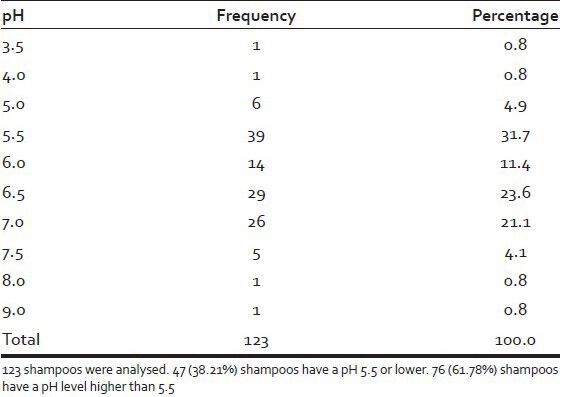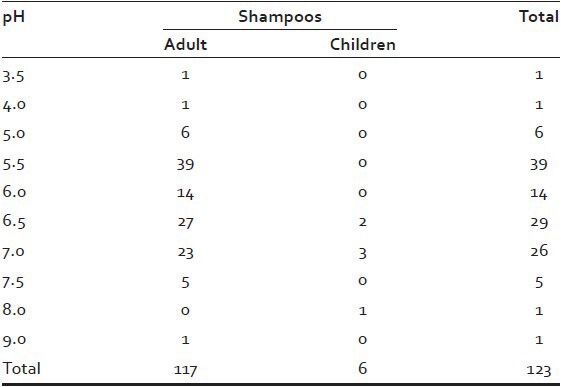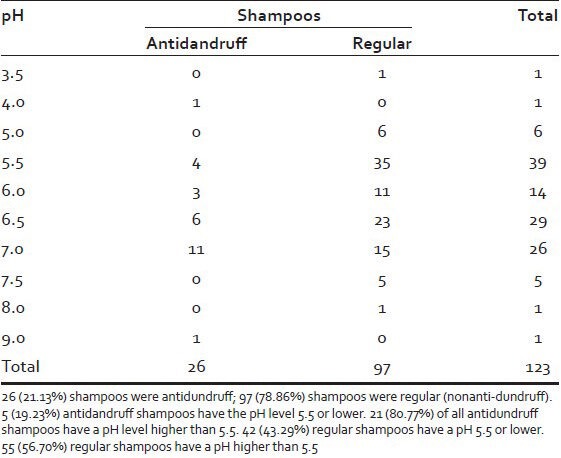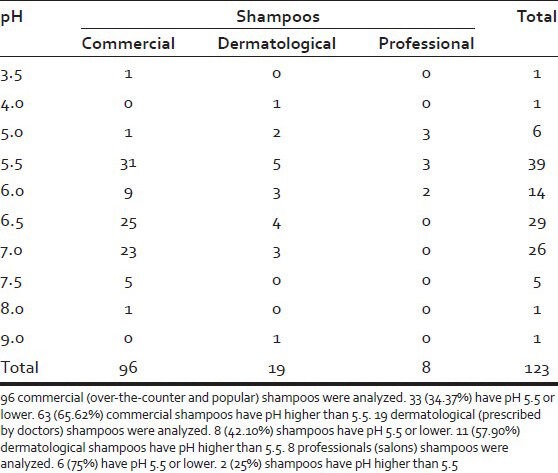Abstract
Aim:
Dermatologists most frequently prescribe shampoos for the treatment of hair shed and scalp disorders. Prescription of hair care products is often focused on improving scalp hair density, whereas the over-the-counter products focus on hair damage prevention. Little is taught in medical schools about the hair cosmetics, so that the prescriptions are based only on the treatment of the scalp and usually disregards the hair fiber health.
Materials and Methods:
In this work, we review the current literature about the mode of action of a low-pH shampoo regarding the hair shaft's health and analyze the pH of 123 shampoos of international brands.
Results:
All shampoo pH values ranged from 3.5 to 9.0. 38.21% of all 123 shampoos presented a pH ≤ 5.5 (IC: 29.9–47%) and 61.78% presented a pH > 5.5. 26 anti-dandruff shampoos were analyzed. About 19.23% presented pH ≤ 5.5.(IC: 7.4–37.6%). 80.77% of all anti-dandruffs shampoos presented a pH > 5.5. The dermatological shampoo group (n = 19) presented 42.10% with pH ≤ 5.5 (IC: 21.8–64.6%), and 57.90% with pH > 5.5. Among the commercial (popular) products (n = 96), 34.37% presented pH ≤ 5.5 (IC: 25.4–44.3%) and 65.62% presented pH > 5.5. 15 professional products (used in hair salons) were analyzed, of which 75% had a pH ≤ 5.5 (IC: 18–65, 4%), and 25% had a pH > 5.5. 100% of the children's shampoos presented a pH > 5.5.
Conclusions:
Alkaline pH may increase the negative electrical charge of the hair fiber surface and, therefore, increase friction between the fibers. This may lead to cuticle damage and fiber breakage. It is a reality and not a myth that lower pH of shampoos may cause less frizzing for generating less negative static electricity on the fiber surface. Interestingly, only 38% of the popular brand shampoos against 75% of the salons shampoos presented a pH ≤ 5.0. Pediatric shampoos had the pH of 7.0 because of the “no-tear” concept. There is no standardized value for the final pH. The authors believe that it is important to reveal the pH value on the shampoo label, but studies are needed to establish the best pH range for both the scalp and the hair fiber's health.
Keywords: Hair care, hair fiber, shampoo, shampoo pH
INTRODUCTION
Dermatologists most frequently prescribe shampoos for the treatment of hair and scalp disorders.[1,2] Prescription hair care products are often focused on improving scalp hair density, while only the over-the-counter products seem to focus on hair damage prevention.[3] Little is taught in medical schools about the hair cosmetics so that the prescriptions are based only on the active substance for the treatment of the scalp and usually disregards the hair fiber structure.[4,5,6,7,8] It is important that dermatologists prescribe shampoos that minimize the risk of frizz and interfiber friction augmentation. Choosing the right shampoo will help dermatologists to increase the patient's adhesion to any treatment involving shampoos.
Shampoos are not only scalp cleaners, because they also act on the hair shaft.[9] It is desirable that whatever may the disease or scalp condition be (dermatitis, seborrhea, alopecia, psoriasis), the shampoo must preserve the softness, comparability and shine of the hair shaft.[2,10,11] Friction, the main cause of frizz, can be minimized by adequate formulation of cleaning products, which is particularly important for African hair and curly hair.[12,13,14,15]
There are many factors that influence the final aesthetic result of the use of shampoos, such as concentration and quality of surfactants, addition of antistatic and lubricating agents and the final pH.[1,13,14,15,16,17,18]
The scalp pH is 5.5, and the hair shaft pH is 3.67. An alkaline pH may increase the negative electrical net charge of the hair fiber surface and, therefore, increase the friction between the fibers.[12,17]
In this work, we review the action of the surfactants and the influence of the pH on the hair fiber friction, regarding the electrical charges on the surface of the shaft and its consequences on the frizz effect.[12,17]
We also analyze the pH of 123 commercially available shampoos of international brands to verify if the pH levels follow a constant pattern.
Surfactants
Surfactants are cleaning agents that substituted soap. They act through the weakening of the physicochemical adherence forces that bind impurities and residues to the hair. Surfactants dissolve these impurities, preventing them from binding to the shaft or the scalp. Residues are non-soluble fats (sebum) that do not dissolve with water. In order to be removed from the hair shaft, surfactants present a hydrophobic molecular portion and another hydrophilic. The former will chemically bond with the fat while the latter with the water. The surfactants are composed of a lipidic chain of hydrocarbons with a polar extremity and a non-polar one. The polar edge is capable of giving this portion of the molecule hydrophilic traits that allow it to dissolve in water and wash away the residues. The surfactants in contact with the water attain the structural formation of a micelle.[14,19,20] Their structure becomes spherical with a hydrophilic exterior, which can be rinsed with water, and a hydrophobic interior where the fats and residues are binded.[15,21] Depending upon the electric charge of the polar extremity, the surfactants are classified in four groups: Anionic, cationic, amphoteric and non-ionic. The main cleansing agents are anionic. The soap, which is also an anionic detergent, in contact with water, leaves an alkaline residue that is very harmful to the hair and skin and that precipitates in the form of calcium salts, which accumulate in the hair strands, leaving them opaque and tangled.[22] Such effects do not happen with the new anionic surfactants that are derived from the sulfation of fatty acids and analog polioxiethilenes (alquil sulfates, alquil ether sulfates), which are smooth cleansers and cosmetically superior. Some examples are: Sodium lauryl sulfate, ammonium lauryl sulfate, ammonium laureth sulfate, alpha olefin sulfonate.[1,10,11,16] The current expression “sulfateless shampoo” refers to a preparation without the anionic surfactant. An example of a surfactant with sulfate is the sodium lauryl sulfate.
Cationic, amphoteric and non-ionic surfactants are added to some shampoo formulas to reduce the static electricity generating effects caused by the anionic surfactants.[16,17,23] Since they carry a positive charge, cationic surfactants bond quickly to the strands negatively charged due to the use of anionic surfactants and reduced the frizz effect. Besides, they optimize the formation of foam and the viscosity of the final product 9.[6,9,16,24] The static electricity verified after the use of shampoo is exactly the result of a balancing out between the electric charges during the removal of sebum and residue. Negative charge of the hair fiber repels the also negative charge of the micelle. The repulsion of charges allows rinsing with water.[4,10,11,16,25] However, the result is an increase of the preexisting negativity of the strands and the formation of stable complexes that bond with the keratin, creating a repulsion between the strands due to excessive static electricity. Although the cationic agents try to neutralize this effect, there is the interference of the shampoo pH, which can increase the static electricity and reduce charge neutralization.[15,18,19,22]
pH: Definition and importance
The pH, or hydrogenionic potential indicates the acidity, alkalinity or neutrality of a given medium. The pH scale assumes the neutrality at 7.0, and varies from 1 to 14.[16,26] A substance is considered acid above 7.0, and alkaline below 7.0. At the 7.0 pH, there is an equilibrium between H+ and OH+ at the center. The isoelectric point is defined as the moment of charge neutrality in a determined pH. The hair is extremely sensitive to the pH variation of the products applied in its surface. The pH of which a protein or particle has an equivalent number of total positive and negative charges is called the isoionic point. The pH at which a protein or particle does not migrate in an electric field is the isoeletric point.
Its isoelectric point is around a 3.67 pH. The isoionic point is around 5.6.[16] The hair reaches neutrality of charges when the pH is around the isoeletric point. In lightened hair, the isoelectric point is reached at an even more acid pH. It occurs because the A-layer and the epicuticle are rich in cysteine and therefore there is the formation of cysteic acid. Free lipid which contains fatty acids is an important and essencial component of the surface of animal hairs. The freer lipid that is present in this surface layers the lower the isoeletric point of the keratin fibers. Free lipid is important to the adsorption of surfactants and other ingredients onto human hair. The longer the interval between shampoos, the more free lipid and the lower isoeletric point of the hair.[16]
Any product applied on hair that has pH higher than 3.67 causes an increase in the negativity of the electric network of the hair, that is, an increase of static electricity and the repulsion between strands. The fiber surface bears a net negative charge because of its low isoeletric point. Positively charged ions are attracted to the negatively charged surface, thus helping to overcome the electrical barrier for anions.[27]
When the hair is rinsed, the water pH is 7.0. Therefore an increase in negativity occurs and the micelle is repelled (washed out) by the negatively charged strands. The negative electrical net charge generated will tangle the hair and make it hard to comb, thus causing the frizz effect.[14,18] Besides, in alkaline pH, hair has increased capacity to absorb water. Water penetrates the scales that open, hydrating the strand and breaking the hydrogen bonds of the keratin molecule.[16,17,21] Keratin is a spiral, helical molecule that keeps itself in that shape due to chemical bonds between its atoms: Hydrogen, disulfide and ionic bonds and Van der Waals forces.[13,16,28] Water causes hydrolysis, that is, temporarily breaks the hydrogen bonds and makes the molecule malleable and consequently, fragile to the hair strand due to lowering in elasticity and increase in plasticity, which means that the wet hair, if deformed, does not regain its original shape. When that hair is wet, the cuticle scales lift, leading to increased cuticle removal, cuticle fragmentation, and cracks to the fiber axis.[16,17,29]
The pH of the scalp, however, is around 5.5 like the rest of the skin, which is more alkaline than the hair shaft pH. Although there is not a standard definition for the concept of low-pH shampoo, in this work we consider a low-pH shampoo one with a pH of 5.5 and lower.
MATERIALS AND METHODS
This is a transverse and descriptive study, in which shampoos (commercial, dermatological and antidandruff, pediatric) were chosen at random, and in enough quantity from popular pharmacies and major national retailers in the city of Rio de Janeiro. At least, one shampoo was analyzed from each brand.
The pH of all products was evaluated with the portable paper pH indicator from Merck, ranging from 0 to 14 and uncertainty of 0.5. Every measurement was performed and confirmed by three observers.
The pH of the products was enumerated in tables according to the category:
Commercial/popular
Dermatological
Antidandruff
Professional.
The statistical analysis was performed with the PASW Statistics Editor software.
RESULTS
A total of 123 shampoos were analyzed. The pH values ranged from 3.5 to 9.0. About 38.21% of all analyzed shampoos presented a pH ≤ 5.5 (IC: 29.9-47%) and 61.78% presented a pH > 5.5 [Table 1]. 100% of the children's shampoos presented a pH > 5.5 [Table 2]. 26 antidandruff shampoos were analyzed. 19.23% presented pH ≤ 5.5 (IC: 7.4-37.6%). 80.77% of all antidandruffs shampoos presented a pH > 5.5 [Table 3]. The dermatological shampoo group (n = 19) presented 42.10% with pH ≤ 5.5 (IC: 21.8-64.6%), and 57.90% presented pH > 5.5 [Table 4]. Among the commercial products (n = 96), 34.37%) presented pH ≤ 5.5 (IC: 25.4-44.3%) and 65.62% presented pH > 5.5 [Table 4].
Table 1.
Level of pH of all analyzed shampoos (n=123)

Table 2.
Adult and children's shampoos pH

Table 3.
Regular and antidandruff shampoo pH

Table 4.
Commercial, dermatological, and professional shampoos pH

15 professional products (used in hair salons) were analyzed, of which 75% had a pH ≤ 5.5 (IC: 18–65.4%), and 25% had a pH > 5.5 [Table 4].
DISCUSSION
Most of the analyzed products have a final pH higher than the hair shaft pH of 3.6 and even higher than the scalp pH of 5.5. There are no standardized pH for any specific indication of hair shampoo, either commercial/popular, antidandruff or dermatologically prescribed products.
The pH level is not a mandatory issue to be printed on the product labels or specified among the product formulation. Such scenario is not observed on the products for professional use in hair salons, in which it is seen 75% of the products, have a pH value within the optimal range of 5.5 or lower. According to the current literature, the usage of shampoo with a pH higher than 5.5 may increase friction and cause frizz, hair breakage and enhance hair tangling.
After using a shampoo of pH higher than 5.5, conditioner of low-pH should be applied so that besides lubricating, the electrostatic forces can be neutralized, the frizz effect eliminated and cuticle scales may be sealed. If the conditioner is not recommended by a dermatologist, it is necessary to choose a shampoo with pH lower than 5.5. Regarding the pediatrics shampoos, one can attribute the higher pH (100% of the samples had a pH higher than 6.0) encountered in the samples, to the fact that they have a major concern “no tears” concept rather than conditioning the hair fiber or the hair scalp.[30] That is why the shampoo pH is closer to the tear physiological pH. The authors believe that adults with dyed hair shaft, especially bleached hair, should not use pediatric shampoos to cleanse and condition their hair.
If the hair cosmetics are formulated above the pH - 3.67, cationic ingredients must be added to the formula in order to be attracted by the negatively charged net. Therefore, the more negative the net is, the more attracted to it are the cationic ingredients added to the formula of the shampoos. If a shampoo formula is above pH - 3.67 and has no cationic ingredients added, the electrostatic forces will considerably increase the tangling and the attrition forces, increasing the damage to the A-layer and the epicuticle of the hair fiber. The prescription of a shampoo treatment formulated without the cationic ingredients will demand the use of conditioner after shampooing. This situation is commonly avoided by dermatologists, which do not encourage the use of hair conditioners due to the possibility of worsening seborrheic dermatitis. For commercial and popular available shampoos, the higher pH might impair the performance of the product regarding compatibility and manageability because of friction and frizz effect. For extremely greasy and thin straight hair it may have a positive effect, of adding volume to the hair. It is of notice that a pH higher than 5.5 may cause irritation of the scalp.
CONCLUSION
There is no standardized value for the shampoo final pH, and this is not a mandatory issue. The pH value is not informed on the labels. As the hair fiber has a pH of 3.67, a pH closer to 3.67 has less possibility to increase the negative electric charge that normally involves the capillary fiber. To address the treatment of the scalp, shampoos must not have a pH higher than 5.5. Most of the commercially available products in Brazil, from international brands, do not fulfill this requirement. Since there is no obligation in specifying this variable (pH) in the formula, it is the dermatologists’ duty to demand the inclusion of antistatic agents in the formulas of shampoos and conditioners. Ideally, however, this rule should apply to any hair product since we know that it is important for the final result of using them. It is important that the dermatologist know that, besides the inclusion of antistatic agents in the shampoo and conditioner formulas, the formula and ingredients must create a final pH no higher than 5.5 so not to damage the scalp. We consider that, to reduce aggression against the strands and allow adequate access to the treatment of the scalp issues, hair care cosmetic should not overcome the pH of 5.5, as to avoid a significant increase in static electricity and consequently, in the negativity of the hair fiber that causes frizz.
Although the products were collected at the Brazilian pharmacies, the brands are international famous brands and may be found all over the world.
Further works are needed to compare the performance of different levels of pH shampoo's formulas and their cationic ingredients present in the chassis as well as the type and percentage of the surfactants.
Footnotes
Source of Support: Nil
Conflict of Interest: None declared.
REFERENCES
- 1.Trüeb RM. Shampoos: Composition and clinical applications. Hautarzt. 1998;49:895–901. doi: 10.1007/s001050050844. [DOI] [PubMed] [Google Scholar]
- 2.Draelos ZD, Kenneally DC, Hodges LT, Billhimer W, Copas M, Margraf C. A comparison of hair quality and cosmetic acceptance following the use of two anti-dandruff shampoos. J Investig Dermatol Symp Proc. 2005;10:201–4. doi: 10.1111/j.1087-0024.2005.10127.x. [DOI] [PubMed] [Google Scholar]
- 3.Davis MG, Thomas JH, van de Velde S, Boissy Y, Dawson TL, Jr, Iveson R, et al. A novel cosmetic approach to treat thinning hair. Br J Dermatol. 2011;165(Suppl 3):24–30. doi: 10.1111/j.1365-2133.2011.10633.x. [DOI] [PubMed] [Google Scholar]
- 4.Draelos ZD. Essentials of hair care often neglected: Hair cleansing. Int J Trichology. 2010;2:24–9. doi: 10.4103/0974-7753.66909. [DOI] [PMC free article] [PubMed] [Google Scholar]
- 5.Draelos ZD. Commentary: Healthy hair and protein loss. J Am Acad Dermatol. 2010;62:409–10. doi: 10.1016/j.jaad.2009.07.020. [DOI] [PubMed] [Google Scholar]
- 6.Draelos ZD. London: Taylor and Francis; 2005. Hair Care; An illustrated Dermatologic Handbook; p. 217. [Google Scholar]
- 7.Draelos ZD. Shampoos, conditioners, and camouflage techniques. Dermatol Clin. 2013;31:173–8. doi: 10.1016/j.det.2012.08.004. [DOI] [PubMed] [Google Scholar]
- 8.Draelos ZD. Hair cosmetics. Dermatol Clin. 1991;9:19–27. [PubMed] [Google Scholar]
- 9.Gray J, Thomas J. Hair care: Textbook of Cosmetic Dermatology. In: Baran R, Maibach HI, editors. 4th ed. New York: Informa Healthcare; 2010. pp. 218–28. [Google Scholar]
- 10.Abraham LS, Moreira AM, Moura LH, Dias MF. Hair care: A medical overview (part 1) Surg Cosmet Dermatol. 2009;1:130–6. [Google Scholar]
- 11.Abraham LS, Moreira AM, Moura LH, Dias MF. Hair care: A medical overview (part 2) Surg Cosmet Dermatol. 2009;1:178–85. [Google Scholar]
- 12.Sinclair RD. Healthy hair: What is it? J Investig Dermatol Symp Proc. 2007;12:2–5. doi: 10.1038/sj.jidsymp.5650046. [DOI] [PubMed] [Google Scholar]
- 13.Wolfram LJ, Albrecht L. Torsional behavior of human hair. J Soc Cosmet Chem. 1985;36:87–99. [Google Scholar]
- 14.LaTorre C, Bhushan B. Nanotribological characterization of human hair and skin using atomic force microscopy. Ultramicroscopy. 2005;105:155–75. doi: 10.1016/j.ultramic.2005.06.032. [DOI] [PubMed] [Google Scholar]
- 15.Savitha A, Sacchidanand S, Revathy T. Bubble hair and other acquired hair shaft anomalies due to hot ironing on wet hair. Int J Trichology. 2011;3:118–20. doi: 10.4103/0974-7753.90832. [DOI] [PMC free article] [PubMed] [Google Scholar]
- 16.Robbins CR. The physical properties and cosmetic behavior of hair. In: Robbins CR, editor. Chemical and Physical Behavior of Human Hair. 5th ed. New York: Springer-Verlag; 2012. [Google Scholar]
- 17.Robbins CR, Crawford RJ. Cuticle damage and the tensile properties of human hair. J Soc Cosmet Chem. 1991;42:59–67. [Google Scholar]
- 18.Gruber JV, Lamoureux BR, Joshi N, Moral L. The use of x-ray fluorescent spectroscopy to study the influence of cationic polymers on silicone oil deposition from shampoo. J Cosmet Sci. 2001;52:131–6. [PubMed] [Google Scholar]
- 19.Rushton H, Gummer CL. Flasch H 2-in-1 shampoo technology: State-of-the-art shampoo and conditioner in one. Skin Pharmacol. 1994;7:78–83. doi: 10.1159/000211278. [DOI] [PubMed] [Google Scholar]
- 20.Ruetsch SB, Kamath YK, Kintrup L, Schwark HJ. Effects of conditioners on surface hardness of hair fibers: An investigation using atomic force microscopy. J Cosmet Sci. 2003;54:579–88. [PubMed] [Google Scholar]
- 21.O’Lenick T. Anionic/cationic complexes in hair care. J Cosmet Sci. 2011;62:209–28. [PubMed] [Google Scholar]
- 22.Jones LN, Rivett DE. The role of 18-methyleicosanoic acid in the structure and formation of mammalian hair fibres. Div Wool Technol. 1997;28:469–85. doi: 10.1016/s0968-4328(97)00039-5. [DOI] [PubMed] [Google Scholar]
- 23.Gao T, Pereira A, Zhu S. Study of hair shine and hair surface smoothness. J Cosmet Sci. 2009;60:187–97. [PubMed] [Google Scholar]
- 24.Trüeb RM Swiss Trichology Study Group. The value of hair cosmetics and pharmaceuticals. Dermatology. 2001;202:275–82. doi: 10.1159/000051658. [DOI] [PubMed] [Google Scholar]
- 25.Trüeb RM. Haarwaschmittel (Shampoos): Zusammensetzung und klinische anwendungen. Hautarzt. 1998;49:895–901. doi: 10.1007/s001050050844. [DOI] [PubMed] [Google Scholar]
- 26.Rushton H, Gummer CL. Flasch H 2-in-1 shampoo technology: State-of-the-art shampoo and conditioner in one. Skin Pharmacol. 1994;7:78–83. doi: 10.1159/000211278. [DOI] [PubMed] [Google Scholar]
- 27.Harris DC. 6th ed. Rio de Janeiro: LTC; 2005. Medida do pH com um eletrodo de vidro. Análise Química Quantitativa; pp. 312–9. [Google Scholar]
- 28.Peteres RH. Dyeing theories based on the latest research data. Ciba Rev. 1964:2–29. [Google Scholar]
- 29.Obukowho P, Birman M. Hair curl relaxers: A discussion of their function, chemistry, and manufacture. Cosmet Toiletries. 1995;110:65–9. [Google Scholar]
- 30.Persaud D, Kamath YK. Torsional method for evaluating hair damage and performance of hair care ingredients. J Cosmet Sci. 2004;55(Suppl):S65–77. [PubMed] [Google Scholar]
- 31.Morelli JG, Weston WL. Soaps and shampoos in pediatric practice. Pediatrics. 1987;80:634–7. [PubMed] [Google Scholar]


